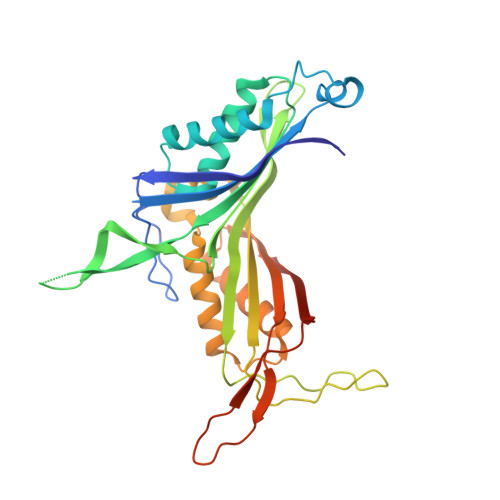Identification of quasi-stable water molecules near the Thr73-Lys13 catalytic diad of Bacillus sp. TB-90 urate oxidase by X-ray crystallography with controlled humidity.
Hibi, T., Itoh, T.(2021) J Biochem 169: 15-23
- PubMed: 33002140
- DOI: https://doi.org/10.1093/jb/mvaa114
- Primary Citation of Related Structures:
7CUC, 7CUF, 7CUG - PubMed Abstract:
Urate oxidases (UOs) catalyze the cofactor-independent oxidation of uric acid, and an extensive water network in the active site has been suggested to play an essential role in the catalysis. For our present analysis of the structure and function of the water network, the crystal qualities of Bacillus sp. TB-90 urate oxidase were improved by controlled dehydration using the humid air and glue-coating method. After the dehydration, the P21212 crystals were transformed into the I222 space group, leading to an extension of the maximum resolution to 1.42??. The dehydration of the crystals revealed a significant change in the five-water-molecules' binding mode in the vicinity of the catalytic diad, indicating that these molecules are quasi-stable. The pH profile analysis of log(kcat) gave two pKa values: pKa1 at 6.07?¡À?0.07 and pKa2 at 7.98?¡À?0.13. The site-directed mutagenesis of K13, T73 and N276 involved in the formation of the active-site water network revealed that the activities of these mutant variants were significantly reduced. These structural and kinetic data suggest that the five quasi-stable water molecules play an essential role in the catalysis of the cofactor-independent urate oxidation by reducing the energy penalty for the substrate-binding or an on-off switching for the proton-relay rectification.
Organizational Affiliation:
Department of Bioscience and Biotechnology, Fukui Prefectural University, 4-1-1 Matsuoka-Kenjojima, Eiheiji, Yoshida, Fukui 910-1195, Japan.





















